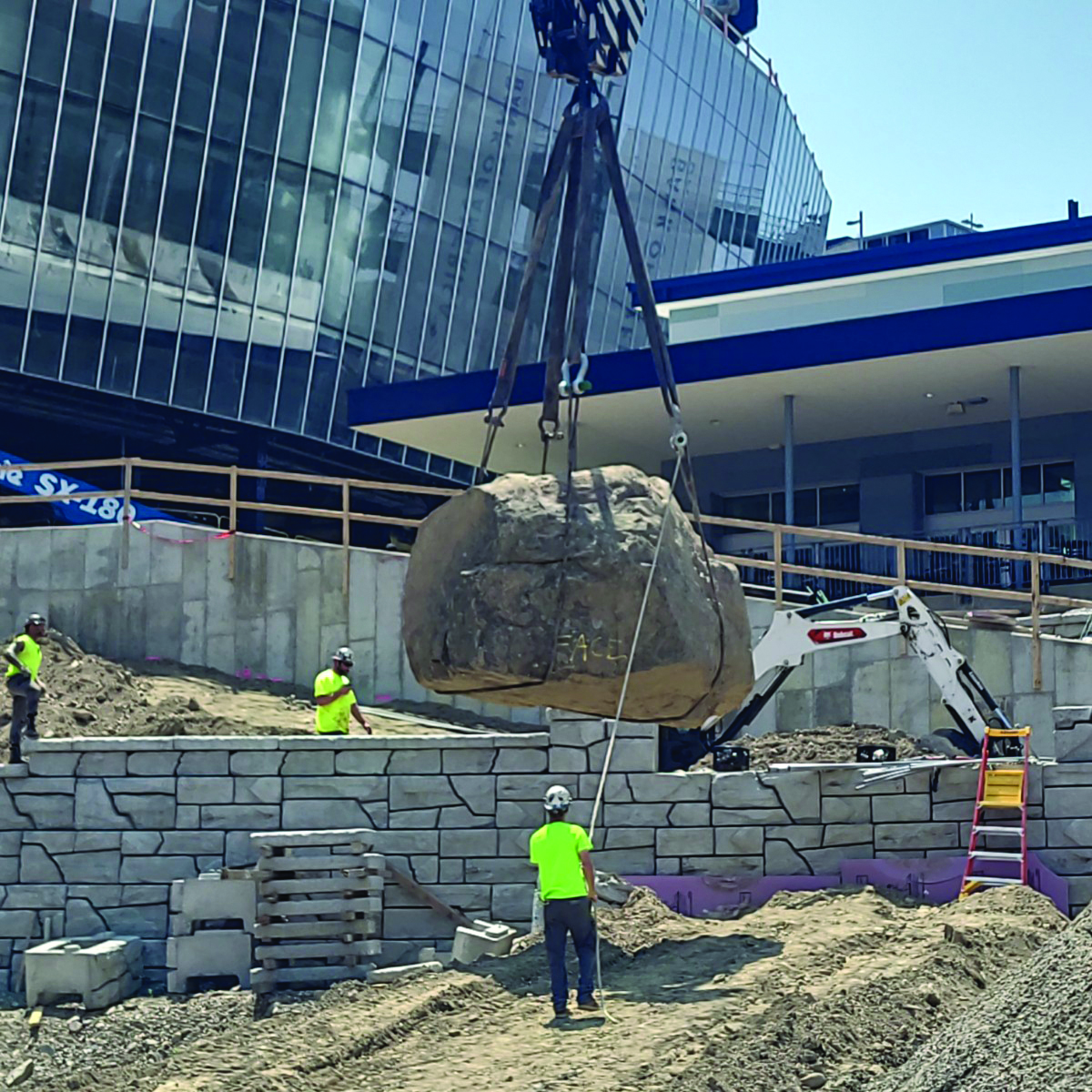
Transitional maintenance. Vendor-managed model. Burn rate. These are a few economics strategies Greenscape practices to expand the family-owned business in a profitable, calculated way.
Transitional maintenance is a company-wide mindset of ensuring that construction clients move into long-term maintenance contracts. A vendor-managed model describes Greenscape’s approach to partnering with local landscape companies equipped to deliver snow services. And burn rate is the number CEO Joe Ciffolillo watches to weather ups and downs profitably.
“The key from early on has been to make sure we temper decisions when investing in people or assets and focus on ROI,” Ciffolillo says.
Greenscape is No. 48 on the Lawn & Landscape 2023 Top 100 list and has grown at this pace without tapping into private equity.

How did Greenscape gradually climb from a startup to a $58 million multi-state firm? Ciffolillo points to a focus on examining investment in the business through an ROI lens, a satellite-to-branch expansion model founded on tested systems and a team of tenured managers.
A Balanced Approach
Joe and Jon Ciffolillo started Greenscape in 1987 with a few other guys. “There wasn’t a big plan or rollout or strategy,” he says, adding that they were working for a developer with a landscaping arm and decided they could do it themselves.
In the early years, Greenscape only provided commercial landscape construction services. “We didn’t do maintenance and we were proud of that, which shows you how little we knew back then because now it’s a different ballgame,” Ciffolillo says.
Within five years, the company added commercial maintenance to the mix, recognizing in the early 1990s that construction cycles required a balancing force of revenue. In Greenscape’s time, the company has pulled through several recessions, and balance is the key.

“You borrow money, take on debt to complete jobs so you can earn more money than you invested. If someone pays you for a contract, you take out your materials, labor, equipment, and all the stuff that comes below the line and call it a ‘burn rate,’” describes Ciffolillo, who earned an economics degree from Bucknell University.
He adds, “It’s easy to wind all that stuff up, and it’s difficult to unwind if you need to do so quickly. If you have a three-year loan and end up in a recession one year, that loan doesn’t go away.”
Of course, this has happened to Greenscape. “But we leverage our cash and invest equity back into the business to keep that monthly burn rate to a number we can weather a downturn in,” he says.
This practice has fostered profitable growth for decades.
“If you peel back the layers — the core business and importance of recurring revenue — we have grown at a steady rate,” Ciffolillo says, adding that during the past couple of years, the company “didn’t explode like the numbers make it look like we did.”
Again, it’s all about balance.
During the pandemic, Greenscape shifted more toward maintenance because the work continued and it was even more profitable because properties lacked the usual traffic. “There weren’t cars in our way and with so many people working remotely, they weren’t as engaged on the property,” he says. “So, that core business — landscaping and snow — grew.”
Construction jobs under contract halted. They didn’t go away. “The wheels just stopped turning,” Ciffolillo says. Meanwhile, price increases and supply chain challenges entered the picture, and Greenscape’s approach was to be nimble with estimating and empower account managers to have transparent discussions with clients.
“We might have provided a quote for a material a month earlier and we went to buy it and it cost twice as much,” he says. “So, keeping those lines of communication open about supply chain and cost issues and not burying them leads to more effective, proactive solutions. The result has been better margins on construction jobs.”
Once construction projects that were a work-in-progress were greenlighted to continue and signed contracts were scheduled, Greenscape built a hefty backlog. This is how numbers spiked in 2022.
A lot of next year’s work is for repeat clients.
“We get selected to do a lot of direct work for owners on jobs where there is no general contractor,” he says. “That’s a sweet spot for us because it shows the client trusts us to manage a large-scale project and do the right thing. We love that because it fits into our game plan.”
And that game plan is transitional maintenance: converting construction projects into long-term maintenance contracts.
All branches know and practice the strategy.
“We go into construction jobs knowing that we want to sign a multi-year maintenance contract,” Ciffolillo says.
It doesn’t always work, but usually the plan comes to fruition. “At a certain point in a construction job, the last thing a property owner is thinking about is how to maintain the grounds — they are just focused on finishing and kind of out of gas,” he says. “At that point, we make it easy for them. And by then, we have built a solid relationships built on trust and that creates long-term value.”
Growth through Partnership
Greenscape has gradually expanded its footprint, now with branches that extend from Virginia through Massachusetts and into Connecticut and New Hampshire. During its long run of organic growth, Greenscape has finetuned its systems, allowing it to move into new markets first as satellites, then branch offices.
The initial satellite approach allowed Greenscape to test systems and grow a customer base in new markets. Again, it’s about ROI, balance and burn rate — making sure the company isn’t over leveraged in case the plan doesn’t work. Once capacity pushed that model to the limits, the company converted satellites into branch offices. Now there are nine locations including headquarters.
Last year, Greenscape acquired Quality Grounds, a smaller company servicing Richmond and Fredericksburg, Va.
“They had amazing clients, amazing employees and amazing retention,” Ciffolillo says of the ideal fit, which extended its existing Fairfax market farther south.
Another important way Greenscape expands is through its vendor-managed model, meaning key people in the business like branch managers are overseeing accounts that are serviced by partner contractors.
In particular, this model allows Greenscape to push snow for major, multi-site national retailers, drug store chains and banks.
This partnership approach also helps grow a larger geographic area for snow services.
“We determined that the bigger the footprint, the more that snow business levels out if it’s a slow year,” Ciffolillo says. Basically, the company can cover areas where snow is falling and compensate for regions where it is not.
Also important is to diversify snow account types — fixed, hourly and per push — also evens out revenue.
In slow snow years, the fixed accounts balance out a lack of hourly and per-push work. During heavy snow seasons, the hourly and per push accounts raise revenues.
And Greenscape sets a cap for fixed accounts. “Our branches in New Hampshire can get crushed with snow, so if it snows over a certain amount like a 60-inch ceiling, the contract goes to per-hour after that point,” Ciffolillo explains.
Ultimately, he compares the snow strategy to diversifying a stock portfolio.
“If you diversify well and really get into the percentages, you’re safe,” Ciffolillo says.
As for expansion, Greenscape’s branch managers and leadership personally meet with owners of local landscape and snow companies in their areas. “It’s a lot of hand-shaking and face-to-face and networking,” Ciffolillo says.
Most are family-owned and have equipment but not necessarily the time to sell snow accounts. So Greenscape basically operates as the “headquarters” for these partner contractors. Greenscape feeds them accounts like a retail client with 10 sites, and the company also manages the contracts and financials, paying out subcontractors.
“It has to be mutually beneficial,” Ciffolillo says. “We built a stable network of subcontractors who love to work for us, so we can service 300 snow locations in the Virginia market for a national company without any boots on the ground in terms of fixed assets.”
For the subcontractor partners, there is stability and a sales funnel they don’t have to manage.
“An owner-operator of a quality company who has family, responsibilities and financial needs can be in a precarious position if he has to make payments on equipment and there is not a way to drive income (because of no snow),” Ciffolillo says, adding that Greenscape supports its partners since the company is regionally leveraged to handle ups and downs.
“We try to help them out,” he adds.

Explore the December 2023 Issue
Check out more from this issue and find your next story to read.
Latest from Lawn & Landscape
- Landscape Workshop acquires Tampa's A-Stellar Property Maintenance and Landscaping
- Husqvarna debuts 590BTS and 590BFS backpack blowers
- Kress showcases its automower Cut N Go
- Kress releases new autonomous mower details
- Landscape Workshop acquires EdgeForm Landscape Management
- Caterpillar's Umpleby transitions to executive chairman
- Sgro named Yanmar Compact Equipment's North American president
- APHIX acquires Curb Appeal Landscaping in Birmingham





